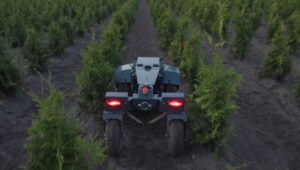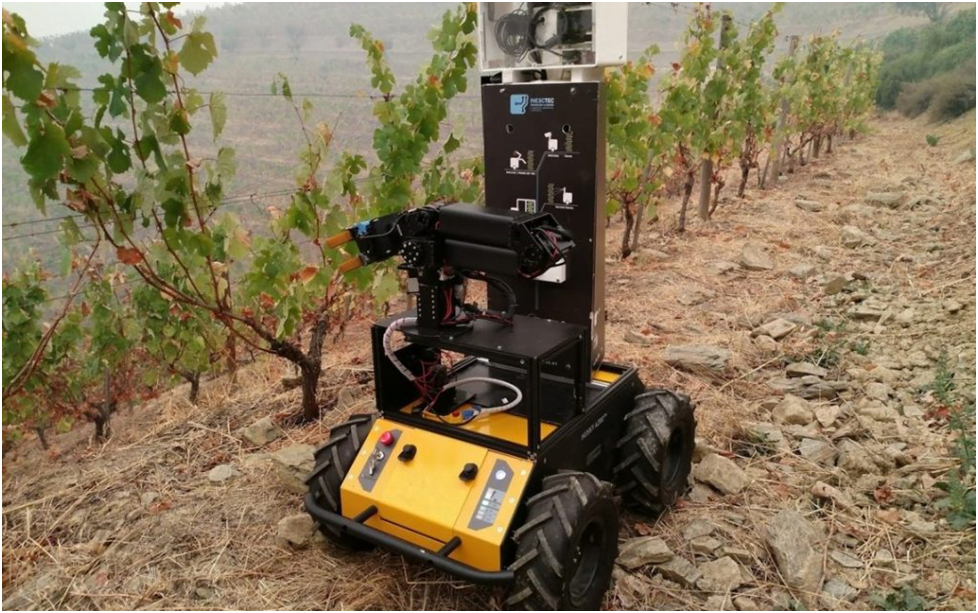Farmer robots, agribots grow and harvest crops. Besides, they perform other tasks complex and monotonous for a man – those related to loading, watering, fertilizing, weeding, data collection, field mapping, soil analysis, environmental monitoring, etc.
Harvesting of orchards requires the efforts of thousands of seasonal workers. Picking fruit is a low-payed, seasonal, repetitive job with little career advancement. The pickers are aging, and the younger generation is migrating to the cities in search of year-round and higher-paying full-time jobs. Current labor costs for a farmer range from 40 to 60%. Robots don’t get tired, they work 24 hours a day, they don’t need any amenities, they don’t go on vacation, and most importantly, they get cheaper and improve every year.
The following agribots, cobots, and self-propelled intelligent systems are used to pick apples, pears and other fruits: fruit-picking drones Tevel Aerobotics Technologies, Eve, Mars, FFRobotics robots. Strawberry harvesting robots are Rubion, Soil Bot, Agrobot. Raspberries and watermelons are harvested by Fieldwork Robotics. There are also asparagus harvesting robots Sparter Virginia Tech, tomato harvesting robots by GRoW, and Vegebot for lettuce.
Harvesting, trimming, and sorting robots
Robots for horticulture can carefully cut leaves, harvest fruits and vegetables, analyze and sort vegetables and fruits by quality. These smart assistants are usually equipped with “hands” to perform a wide range of tasks in orchards. For example, the Laboratory for Adaptive Robotics (SAR) at the University of Plymouth, led by Dr. Martin Stolen, is developing “soft robotic arm technology” for selective harvesting in horticulture. Parts of the robotic arm can change their rigidity in real time, softening to withstand impact during the fast phases of movement towards the fruit and vice versa to ensure accuracy during the approach and capture phase.
Dr. Stolen also works in the autonomous and selective harvesting of raspberries and tomatoes within the China Robot Harvest project. He is studying how the technology can be applied to cauliflower within the framework of the Cornwall Automated Cabbage Harvesting project, part of a three-year Agri-Tech Cornwall initiative funded in part by the European Regional Development Fund and the Cornwall Council.
It is worth noting that most harvesting robot prototypes have high initial investment costs and long payback periods. Few of these robots have passed the prototype stage and gone on sale. By reducing the cost of mass production of robots, the use can be scaled according to the needs of the farmer.
You can watch videos of many different types of harvesting robots. However, there are a few of them on sale today. End of Arm Tooling (EoAT) of harvesting robots differs depending on the type of crop. For example, peppers with a smooth waxy surface can be picked with suction cups. Tomatoes are more fragile than peppers, so the robots use a soft-fingered gripper that twists the fruit when pulling it from the plant. Strawberries are even more delicate, so their harvesting requires special care. For instance, there is a robot grabbing fruits with a stalk knife to avoid damage.

The vision of the robot, using artificial intelligence, determines the ripeness and plans the trajectory of the robotic arm to pick the fruit. Some harvesting robots are equipped with an articulated arm that moves on a wheelbase. Others use tracks like military vehicles.
Some harvesting robots are equipped with two aerial drones. The drones are attached to a wheeled cart that provides electricity. Drones fly next to the cart, using computer vision to find the ripe fruit and take it with pick-up mechanisms. Once harvested, the drone puts the fruit in a basket in the cart. The cart moves down the aisle, and the drones attached to the cart move as needed.
Data collection and analysis systems allow for the identification of the fruit and determine the stage of its ripeness, its readiness for harvest and quality, careful selection and sorting of fruits. The help of artificial intelligence allows the robot to control the life cycle of the plant more efficiently.
Weeding robots
Some weeding robots for commercial farming use microdoses of herbicides. The robot autonomously moves through the rows. It uses computer vision to distinguish weeds from crops. When a weed is detected, the robot mechanisms are triggered. A small amount of pesticide is deposited on the weed. Consequently, far fewer chemicals are used. Another approach involves the use of lasers to kill weeds. Therefore, this method does not use chemicals and is certified organic. For example, the Swiss ecoRobotix is a robot designed to automatically thin out plantings and weed weeds. EcoRobotix is equipped with a computer vision system designed to identify weeds. It is oriented in space guided by GPS and touch sensors. The robot processes about 3 hectares of crops per day and if necessary, sprays the weed with a small dose of herbicide. This approach reduces the amount of chemicals used by 2-3 times.

Some weeding robots are equipped with solar panels for power, while others use batteries or diesel fuel.
AIGRO UP, an autonomous Dutch robot, can also perform tasks such as weeding and mowing. It is designed to be lightweight yet powerful enough to last up to 10 hours between charges.
One of the global players in the market of self-propelled horticulture solutions is AGROBOT. Agrobot E-Series made for the fruit and vegetable business is an innovative generation of strawberry-picking robots. These machines have been designed to work autonomously in rows on any plantation.
AGROBOT is also a developer of Bug Vacuum robots for pest control. The Bug Vacuum robot moves around the field on its own, so the farmer just needs to bring it to the starting point and select “Automatic mode”. The robot recognizes row spacings as navigational landmarks if it is within the row. As soon as the furrows are finished, the navigation controller decides what to do next: go to the next row, turn around or finish the job.
The Bug Vacuum has a dual-fan vacuum system that provides uniform airflow across the entire width. Optimum vacuum pressure is achieved through precise fan height control, which maximizes insect aspiration. In line with food safety standards, the fan inlet is made of stainless steel and food grade silicone.
Another world-known company is NAIO-TECHNOLOGIES – the developer of automated self-propelled equipment for fruit and vegetable growing (France). All robots are powered by RTK GPS navigation, which provides farmers with accurate weeding. The environmental friendliness of the process and respect for the soil is one of the important elements of the work of NAIO-TECHNOLOGIES robots. These technologies solve the problem of a shortage of agricultural workers, reduce heavy physical work and limit the use of chemical herbicides.
Today, more than 200 Naïo robots solve weeding problems around the world.
The company manufactures such robots as DINO autonomous self-propelled weeding robot for vegetable crops. It autonomously navigates the field with an accuracy of up to 2 cm thanks to a guidance system that combines information from RTK GPS and other sensors. Dino locates rows of crops and adjusts tools to weed as close to the plants as possible.
DINO works on crops such as lettuce, onions, carrots, parsnips, cabbage, leeks, cauliflower, and various herbs (garlic, cilantro, mint, etc.)
Another solution of the company is OZ, a multifunctional agricultural assistant robot for labor-intensive and complex tasks, such as loosening, weeding, furrowing, and sowing.
The company’s self-propelled robot, TED, is designed for vineyards. Its advantages are efficient and precise mechanical weeding without herbicides, protecting your soil and crops. It works 8 hours a day and is easily equipped with various tools for working in the field.
BoniRob, GREENBOT, KUBOTA, LADYBIRD ROBOT, Husky UGV and other intelligent robots are designed to work in vineyards, berry fields, orchards and vegetable crops.

The development of robotics will go along with the development of new technologies in breeding. So, over time, many varieties of vegetables and fruits will also be adapted to the work of robots. That is, there will be collaborations between manufacturers of robots and breeders of various types of vegetables and fruits.
The use of the site materials is free if there is a direct and open for search engines hyperlink to a specific publication of the East-Fruit.com website.




